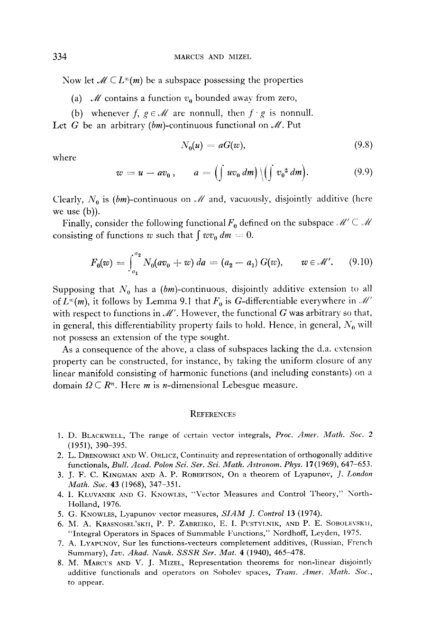Extension Theorems of Hahn-Banach Type for Nonlinear Disjointly ...
Extension Theorems of Hahn-Banach Type for Nonlinear Disjointly ...
Extension Theorems of Hahn-Banach Type for Nonlinear Disjointly ...
Create successful ePaper yourself
Turn your PDF publications into a flip-book with our unique Google optimized e-Paper software.
334 MARCUS AND iVIIZEL<br />
Sow let ~2’ CLV-(m) be a subspace possessing the properties<br />
(a) ,&’ contains a function uu bounded away from zero,<br />
(b) whenever f, g E JZZ are nonnull, then .f. g is nonnull.<br />
Let G be an arbitrary (bm)-continuous functional on ~2’. Put<br />
where<br />
Xf,(u) = aG(w), (9.8)<br />
20 = u - av() ) a = (1’ uv,, dm) \,(J v()2 dm).<br />
Clearly, NO is (bm)-continuous on JY and, vacuously, disjointly additive (here<br />
we use (b)).<br />
Finally, consider the following functional F,, defined on the subspace /2” C i ti<br />
consisting <strong>of</strong> functions za such that j ZU’Z’~ dnz mm: 0.<br />
F,,(w) = (.n2iVo(av, + w) da = (a, - a,) G(w),<br />
. “1<br />
w E J&i?‘. (9.10)<br />
Supposing that ATO has a (hm)-continuous, disjointly additive extension to all<br />
<strong>of</strong> L”(m), it follows by Lemma 9.1 that F,, is G-differentiable everywhere in .J<br />
with respect to functions in ~2’. However, the functional G was arbitrary so that,<br />
in general, this differentiability property fails to hold. Hence, in general, ATO will<br />
not possess an extension <strong>of</strong> the type sought.<br />
As a consequence <strong>of</strong> the above, a class <strong>of</strong> subspaces lacking the d.a. extension<br />
property can be constructed, <strong>for</strong> instance, by taking the uni<strong>for</strong>m closure <strong>of</strong> any<br />
linear manifold consisting <strong>of</strong> harmonic functions (and including constants) on a<br />
domain Q C R”. Here m is n-dimensional Lebesgue measure.<br />
REFERENCES<br />
1. D. BLACICWELL, The range <strong>of</strong> certain vector integrals, Proc. Amer. Math. Sot. 2<br />
(1951), 390-395.<br />
2. L. DRENOWSKI AND W. ORLICZ, Continuity and representation <strong>of</strong> orthogonally additive<br />
functionals, Bull. Acad. Polon Sci. Ser. Sci. Math. Astronom. Phys. 17(1969), 647-653.<br />
3. J. F. C. KING~IAN AND A. P. ROBERTSON, On a theorem <strong>of</strong> Lyapunov, 1. London<br />
Math. Sot. 43 (1968), 347-351.<br />
4. I. KISJVANEK AND G. KNOWUS, “Vector Measures and Control ‘l’heory,” Sorth-<br />
IHolland, 1976.<br />
5. G. KNOWLES, Lyapunov vector measures, SIAM J. Control 13 (1974).<br />
6. M. A. KRASNOSEL’SKII, P. P. ZABREIKO, E. I. PCSTYI.NIK, AND P. E. SOBOLIXSKII,<br />
“Integral Operators in Spaces <strong>of</strong> Summablc Functions,” Nordh<strong>of</strong>f, Leyden, 1975.<br />
7. A. LYAPCNOV, Sur les functions-vecteurs completement additives, (Russian, French<br />
Summary), Izo. Akad. Nauk. SSSH Ser. Mat. 4 (1940), 465-478.<br />
8. M. MARCCX AND V. J. MIZEL, Representation theorems <strong>for</strong> non-linear disjointl!<br />
additive functionals and operators on Sobolev spaces, Trans. Amer. swath. Sot.,<br />
to appear.

















